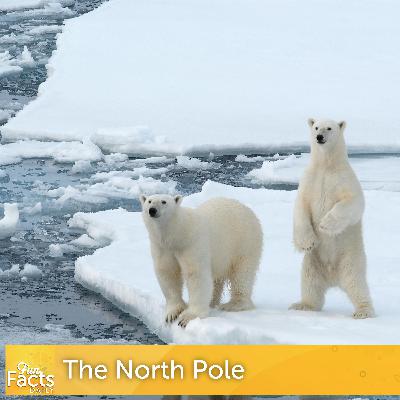Discover Fun Facts Daily
Fun Facts Daily

Fun Facts Daily
Author: Kyle Wood
Subscribed: 46Played: 1,741Subscribe
Share
© Copyright 2025 All rights reserved.
Description
Start your day smarter with Fun Facts Daily. Every episode explores a different topic giving you a quick and easy way to enjoy learning something new every weekday! Fun Facts Daily cuts through the noise of the world to deliver positive, uplifting, and fascinating trivia about art, biographies, geography, history, pop culture, science and anything else that might pique your curiosity. Get your daily dose of knowledge with a word of the day, five fun facts to blow your mind as well as practical tips and tricks that you can actually use. Every episode is safe for work (SFW) and appropriate for curious listeners of all ages.
172 Episodes
Reverse
The Harbin International Ice and Snow Festival transforms the "Ice City" of northeast China into a sprawling winter wonderland of record-breaking proportions. Spanning approximately 800,000 square meters—roughly the equivalent of 80 football fields—this annual event showcases the world's largest collection of illuminated ice architecture and colossal snow carvings. Visitors can explore distinct zones like the Ice and Snow World, famous for its life-sized crystal castles, and the Sun Island Scenic Area, which hosts intricate, massive snow reliefs. The festival’s unique aesthetic is deeply rooted in Harbin’s history, blending traditional Chinese motifs with Russian and European architectural styles, resulting in a frozen landscape featuring everything from onion-domed cathedrals to traditional pagodas.
Beyond the sheer scale, the festival is a masterclass in seasonal engineering and artistry. Sculptors utilize high-clarity ice harvested from the Songhua River and supplement it with deionized water to create glass-like transparency for delicate carvings. While the official opening ceremony takes place on January 5th, the sub-zero temperatures of Heilongjiang province often allow the displays to persist from late December through early March. From the historic ice lantern traditions of Zhaolin Park to modern light displays that draw millions of global tourists, the festival remains a premier destination for winter enthusiasts and a significant driver of the regional economy.
Want to learn more? Head over to my website www.funfactsdailypod.com and be sure to listen to my other podcasts Who ARTed: Weekly Art History for All Ages or Art Smart. For family fun, check out my son's podcast Rainbow Puppy Science Lab
Fun Facts Daily is an Airwave Media Podcast. If you are interested in advertising on this or any other Airwave Media show, email: advertising@airwavemedia.com
Learn more about your ad choices. Visit megaphone.fm/adchoices
The Arctic region, defined by the northern limit of the tree line and the celestial patterns of the "Great Bear" constellation, serves as one of the most unique environments on Earth. Unlike its southern counterpart, the North Pole consists of shifting sea ice floating atop the Arctic Ocean rather than solid land. This geographical distinction creates a fascinating landscape where a single day lasts an entire year. The North Pole sees six months of continuous "Midnight Sun" followed by six months of polar night. Because the ice is constantly drifting, the North Pole lacks a permanent physical marker and functions without an official time zone, as all lines of longitude converge at this singular point.
Beyond the icy scenery, the North Pole presents a study in extreme physics and navigation. The region is home to two distinct poles: the fixed geographic North Pole and the wandering magnetic North Pole, which shifts positions based on the movement of molten iron in the Earth's core. Despite the brutal temperatures, which average -40°F in winter, the Arctic is actually significantly warmer than the South Pole due to the heat-trapping properties of the underlying ocean.
Want to learn more? Head over to my website www.funfactsdailypod.com and be sure to listen to my other podcasts Who ARTed: Weekly Art History for All Ages or Art Smart. For family fun, check out my son's podcast Rainbow Puppy Science Lab
Fun Facts Daily is an Airwave Media Podcast. If you are interested in advertising on this or any other Airwave Media show, email: advertising@airwavemedia.com
Learn more about your ad choices. Visit megaphone.fm/adchoices
Explore the fascinating world of the fox, a clever and highly adaptable member of the canid family. These resourceful predators bridge the gap between canine and feline characteristics, sporting cat-like vertical pupils that provide a distinct advantage for hunting during the twilight hours. From the heat-radiating ears of the tiny Fennec fox in the Sahara to the incredibly dense, color-shifting camouflage of the Arctic fox, these animals showcase some of nature’s most specialized survival adaptations. Listeners will discover the complex social structures of fox families—where "auntie" foxes help raise new litters—and the surprising science behind the "magnetic pounce," a hunting technique where foxes utilize the Earth's magnetic field to strike prey with pinpoint accuracy.
Want to learn more? Head over to my website www.funfactsdailypod.com and be sure to listen to my other podcasts Who ARTed: Weekly Art History for All Ages or Art Smart. For family fun, check out my son's podcast Rainbow Puppy Science Lab
Fun Facts Daily is an Airwave Media Podcast. If you are interested in advertising on this or any other Airwave Media show, email: advertising@airwavemedia.com
Learn more about your ad choices. Visit megaphone.fm/adchoices
Snowboarding traces its modern origins to the 1965 invention of the Snurfer, created by engineer Sherman Poppen as a way to combine surfing and snow play. This early stand-up sled, which sold over a million units, was later adapted by Jake Burton Carpenter, who added bindings and applied engineering principles to the design, transforming it from a toy into the high-performance board known today. However, the idea of riding sideways on snow is not entirely new; for over 400 years, villagers in Patron, Turkey, have used large wooden planks called lazboards to navigate snow-covered roads. Snowboards are also responsible for a major innovation in skiing: the sidecut, or hourglass shape, which allows for easier, arced turns, was popularized by snowboard designers before being adopted by the ski industry. In terms of technique, the Goofy stance, where the rider leads with the right foot, is an officially recognized technical term that originated from a 1937 Disney cartoon featuring the character Goofy surfing.
Snowboarding is an extreme sport defined by both gravity and precision engineering. The world speed record for a snowboarder stands at a breathtaking 126 mph ($203$ km/h), a velocity that requires specialized aerodynamic suits and helmets to manage air resistance. The massive, perfectly sculpted half-pipes used in modern competitions are made possible by the Pipe Dragon, a specialized grooming machine that cuts consistent, smooth curves into the snow, allowing athletes to achieve the momentum necessary for high-flying tricks. Learning to ride typically involves keeping the board perpendicular to the slope and sliding on the uphill heel edge to control speed, using the friction of the edge as a brake. For those seeking the ultimate extreme experience, the sport of volcano boarding exists, where riders slide down the ash and small rocks of active volcanoes, proving that a smooth ride can be found even without snow.
Want to learn more? Head over to my website www.funfactsdailypod.com and be sure to listen to my other podcasts Who ARTed: Weekly Art History for All Ages or Art Smart. For family fun, check out my son's podcast Rainbow Puppy Science Lab
Fun Facts Daily is an Airwave Media Podcast. If you are interested in advertising on this or any other Airwave Media show, email: advertising@airwavemedia.com
Learn more about your ad choices. Visit megaphone.fm/adchoices
Petrology is the branch of science concerned with the origin, structure, and composition of rocks, revealing the deep history of our planet. The Earth's crust is built upon three basic types of rocks: igneous rocks, which solidify from cooling magma or lava; sedimentary rocks, formed when layers of mud, sand, and pebbles are compressed over millennia; and metamorphic rocks, which are pre-existing rocks chemically and structurally transformed by intense heat and pressure deep underground.
Uncovers remarkable phenomena across the globe, from the geometrically perfect hexagonal columns of basalt at the Giant's Causeway, formed by the efficient cooling of volcanic lava, to the rare, flexible sandstone known as Itacolumite. Furthermore, rocks can exhibit unusual properties: certain dense, iron-rich igneous rocks in Pennsylvania can produce metallic musical tones when struck, while seemingly ordinary stones in Michigan, known as yooperlite, contain sodalite that glows bright orange under UV light through a process called fluorescence.
The study of rocks also allows scientists to look back through time. The oldest known formation, the Acasta Gneiss in northern Canada, has been dated to 4.03 billion years old using radiometric dating of trapped zircon crystals, surviving nearly the entire 4.5 billion-year history of Earth.
Not all rocks sink; the highly porous, foamy volcanic rock called pumice floats on water. The molten rock is rapidly cooled trapping gas bubbles inside. These air pockets make its overall density lower than that of water, so it can float.
Want to learn more? Head over to my website www.funfactsdailypod.com and be sure to listen to my other podcasts Who ARTed: Weekly Art History for All Ages or Art Smart. For family fun, check out my son's podcast Rainbow Puppy Science Lab
Fun Facts Daily is an Airwave Media Podcast. If you are interested in advertising on this or any other Airwave Media show, email: advertising@airwavemedia.com
Learn more about your ad choices. Visit megaphone.fm/adchoices
The Jewish Festival of Lights, Hanukkah, commemorates the 164 BCE victory of the Maccabees over the Greek-Syrian forces and the subsequent miracle of a single container of oil lasting for eight days in the rededicated Temple. The centerpiece of the celebration is the Hanukkiah, a nine-branched candelabra distinguished from the seven-branched Temple Menorah. One special candle, the Shamash (helper), is used to light the other eight, ensuring the holy lights remain set apart from everyday use. This tradition is fundamentally rooted in pirsumei nisa (publicizing the miracle), dictating that the Hanukkiah should be displayed prominently, often in front windows or doorways, to broadcast the story of resilience to the outside world.
Many widely recognized Hanukkah traditions have surprising historical origins. The dreidel game, for instance, began as a decoy used by Jewish students to secretly study the Torah when the practice was outlawed. Today, the letters on the sides of the dreidel reference the phrase Nes Gadol Hayah Sham ("A great miracle happened there"). Celebrations often feature deep-fried foods to go along with the miracle of the oil, including popular potato pancakes (latkes) and the ubiquitous Israeli jelly doughnuts (Sufganiyot), with estimates suggesting Israelis consume around 20 million annually. The tradition of chocolate gelt evolved from 17th-century European students giving coins to their teachers as a token of appreciation. Despite its immense cultural popularity and global reach—including being celebrated in space—Hanukkah is considered a minor holiday in Judaism compared to the High Holy Days.
Want to learn more? Head over to my website www.funfactsdailypod.com and be sure to listen to my other podcasts Who ARTed: Weekly Art History for All Ages or Art Smart. For family fun, check out my son's podcast Rainbow Puppy Science Lab
Fun Facts Daily is an Airwave Media Podcast. If you are interested in advertising on this or any other Airwave Media show, email: advertising@airwavemedia.com
Learn more about your ad choices. Visit megaphone.fm/adchoices
Earth’s oceans are the planet's primary life-support system, providing a staggering 94 percent of the world's available living space. While forests are often called the "lungs of the earth," the true powerhouse of oxygen production lies underwater, where microscopic phytoplankton generate between 50 and 80 percent of the oxygen in the atmosphere. Despite this critical importance, the ocean floor remains one of the final frontiers of exploration; scientists currently possess better maps of the surface of Mars and the Moon than they do of Earth's seabeds. In the darkest reaches of this vast habitat, sunlight is replaced by bioluminescence, a "cold light" produced by chemical reactions within living organisms. It is estimated that up to 90 percent of deep-sea animals use this ability to hunt or escape predators in the eternal night.
The physical extremes of the ocean defy imagination, creating environments that seem almost alien. The deepest known point, the Challenger Deep in the Mariana Trench, plunges nearly seven miles down—deep enough to submerge Mount Everest with over a mile of water still above its peak. At these depths, the pressure is equivalent to fifty jumbo jets stacked on a person. Surprisingly, the ocean floor also hosts distinct underwater lakes and rivers known as brine pools, where dense, salty water collects in basins to form toxic shorelines separate from the surrounding sea. Even the ocean's signature blue color is a result of complex physics; rather than simply reflecting the sky, water molecules absorb red light wavelengths and scatter blue light, creating the deep azure hue seen from the surface.
Want to learn more? Head over to my website www.funfactsdailypod.com and be sure to listen to my other podcasts Who ARTed: Weekly Art History for All Ages or Art Smart. For family fun, check out my son's podcast Rainbow Puppy Science Lab
Fun Facts Daily is an Airwave Media Podcast. If you are interested in advertising on this or any other Airwave Media show, email: advertising@airwavemedia.com
Learn more about your ad choices. Visit megaphone.fm/adchoices
Reindeer or caribou are scientifically classified as rangifer tarandus. They go by many names, but they represent a single genetic species adapted to one of the harshest climates on Earth. These animals possess distinct physiological advantages, including the rare ability among large mammals to perceive ultraviolet light, which allows them to spot predators and lichen in high contrast against the snow. Their adaptation extends to a specialized nasal cavity that warms freezing air before inhalation and hooves that alter their structure seasonally. The hooves expand for traction on soft summer tundra and tighten to grip hard winter ice.
Survival in the Arctic also relies on unique social and metabolic mechanisms. Reindeer herds navigate whiteout conditions using audible clicks produced by knee tendons, ensuring the group stays together when visibility is near zero. Their metabolism is equally specialized; mothers produce milk with a 20% fat content to accelerate calf growth, and the species has developed the ability to fulfill sleep requirements while chewing cud. This multitasking adaptation allows them to maximize nutrient intake from moss and lichens while maintaining the fat reserves and internal body heat necessary to withstand sub-zero temperatures.
Want to learn more? Head over to my website www.funfactsdailypod.com and be sure to listen to my other podcasts Who ARTed: Weekly Art History for All Ages or Art Smart. For family fun, check out my son's podcast Rainbow Puppy Science Lab
Fun Facts Daily is an Airwave Media Podcast. If you are interested in advertising on this or any other Airwave Media show, email: advertising@airwavemedia.com
Learn more about your ad choices. Visit megaphone.fm/adchoices
Explore the most baffling riddles of the past, ranging from lost technology and undeciphered texts to unexplained medical phenomena. Discover the secrets of the Antikythera mechanism, an ancient Greek analog computer that predates similar engineering by a millennium, and delve into the unreadable pages of the Voynich Manuscript, a medieval text that has stumped cryptographers and artificial intelligence alike. History also reveals strange human behaviors, such as the Dancing Plague of 1518—where hundreds danced until they collapsed—and the Green Children of Woolpit, who appeared in a 12th-century English village speaking an unknown tongue. Finally, uncover the potential hiding spots of a massive fortune detailed in the Copper Scroll, a unique treasure map found among the Dead Sea Scrolls.
Beyond these historical enigmas, learn the science behind spycraft by creating invisible ink using organic oxidation or UV fluorescence found in household items like laundry detergent and tonic water. Finally, find out whether Napoleon's army really knocked the nose of the Great Sphinx in Egypt. From ancient engineering marvels to the chemistry of secret messages, unearth the facts behind the legends that have puzzled humanity for generations.
Want to learn more? Head over to my website www.funfactsdailypod.com and be sure to listen to my other podcasts Who ARTed: Weekly Art History for All Ages or Art Smart. For family fun, check out my son's podcast Rainbow Puppy Science Lab
Fun Facts Daily is an Airwave Media Podcast. If you are interested in advertising on this or any other Airwave Media show, email: advertising@airwavemedia.com
Learn more about your ad choices. Visit megaphone.fm/adchoices
Gingerbread traces its roots to the Middle East, where Crusaders first encountered the spices and preservation techniques that they brought back to Europe in the 11th century. Originally a dense survival ration made of breadcrumbs and honey, the treat evolved into the refined Lebkuchen of Nuremberg, a soft, spiced cake that still holds a protected designation of origin today. The iconic shape of the gingerbread man appeared later in the English court, invented by Queen Elizabeth I to caricature visiting dignitaries, while the tradition of building elaborate gingerbread houses exploded in popularity in Germany during the 19th century. Inspired by the edible cottage in the Brothers Grimm’s Hansel and Gretel, bakers transformed a dark fairy tale element into a festive symbol of middle-class abundance and artistic skill.
Beyond its history as a confection, gingerbread was once revered for its medicinal value, prescribed by medieval monks and apothecaries to treat indigestion and ward off the plague. Modern science supports these ancient practices, acknowledging the anti-inflammatory properties of gingerol and the pain-relieving effects of cloves. Culturally, the cookies also served as "fairings"—decorated tokens of affection exchanged at village fairs long before paper greeting cards existed. Today, the craft ranges from massive engineering feats, such as the world record-breaking 21-foot house in Texas, to precise home baking, which relies on chilling the dough to solidify butter and preserve the cookie's sharp definition.
Want to learn more? Head over to my website www.funfactsdailypod.com and be sure to listen to my other podcasts Who ARTed: Weekly Art History for All Ages or Art Smart. For family fun, check out my son's podcast Rainbow Puppy Science Lab
Fun Facts Daily is an Airwave Media Podcast. If you are interested in advertising on this or any other Airwave Media show, email: advertising@airwavemedia.com
Learn more about your ad choices. Visit megaphone.fm/adchoices
The Nazca Lines are a collection of massive geoglyphs etched into the desert plains of southern Peru, created by the Nazca culture between roughly 500 BCE and 500 CE. These ancient artworks were constructed using a subtractive technique, where workers removed the top layer of dark, oxidized pebbles to reveal the light, lime-rich soil underneath. The region’s extremely arid climate and stable temperatures have acted as a natural preservation chamber, preventing erosion and keeping these intricate designs intact for thousands of years.
The desert floor serves as a vast art gallery featuring hundreds of geometric lines and biomorphs, including a spider, a monkey, and a humanoid figure often called the "Astronaut." While early myths claimed these figures were invisible from the ground, they can actually be seen from nearby foothills, debunking theories that they required aerial technology to construct. Modern archaeology suggests the lines held deep spiritual significance, likely functioning as ritual pathways where the Nazca people walked to pray for water and fertility in their harsh environment.
Want to learn more? Head over to my website www.funfactsdailypod.com and be sure to listen to my other podcasts Who ARTed: Weekly Art History for All Ages or Art Smart. For family fun, check out my son's podcast Rainbow Puppy Science Lab
Fun Facts Daily is an Airwave Media Podcast. If you are interested in advertising on this or any other Airwave Media show, email: advertising@airwavemedia.com
Learn more about your ad choices. Visit megaphone.fm/adchoices
This month's Family Fun Friday episode is tackling the classic Christmas movie, Home Alone. From John Hughes's lightning-fast writing process to the truth about the gritty gangster film "Angels with Filthy Souls," this deep dive explores the movie magic that turned a modest budget into a Guinness World Record-breaking phenomenon. Discover how a thirty-year-old stuntman stood in for Macaulay Culkin, the improvisational genius of John Candy, and the painstaking work that went into the creation of a slapstick comedy classic.
Want to learn more? Head over to my website www.funfactsdailypod.com and be sure to listen to my other podcasts Who ARTed: Weekly Art History for All Ages or Art Smart. For family fun, check out my son's podcast Rainbow Puppy Science Lab
Fun Facts Daily is an Airwave Media Podcast. If you are interested in advertising on this or any other Airwave Media show, email: advertising@airwavemedia.com
Learn more about your ad choices. Visit megaphone.fm/adchoices
Explore the captivating history and fun facts of American football, from the rough early days of the game to the modern-day spectacle of the Super Bowl. Discover the unlikely connection between the field, known as the gridiron, and a 17th-century cooking grate—a name that stuck due to early fields' grid-like markings. Learn how a presidential ultimatum from Theodore Roosevelt in 1906, aimed at curbing dangerous mass collisions, led to the revolutionary legalization of the forward pass, forever changing the game. The prestigious Lombardi Trophy, which is handcrafted by Tiffany and Company, costs around $50,000 to produce each year. You'll also hear the unbelievable story of the only player to score a touchdown for both teams in a single professional game, a bizarre event in 1926 illustrating the sport's chaotic early rules. Plus, find out about the legendary Operation Flagship, a 1985 sting where law enforcement lured over 100 fugitives with the promise of free football tickets, leading to one of the largest mass arrests in US history.
Want to learn more? Head over to my website www.funfactsdailypod.com and be sure to listen to my other podcasts Who ARTed: Weekly Art History for All Ages or Art Smart. For family fun, check out my son's podcast Rainbow Puppy Science Lab
Fun Facts Daily is an Airwave Media Podcast. If you are interested in advertising on this or any other Airwave Media show, email: advertising@airwavemedia.com
Learn more about your ad choices. Visit megaphone.fm/adchoices
Uncover the fascinating science of snow, from its insulating properties to unique natural phenomena. Fresh snow is primarily 90-95% trapped air, which makes it incredibly light and acts as a superb insulator. This structure stabilizes temperatures in the Subnivan Zone near the ground, helping small animals survive winter. Discover the term chionophile, which describes both organisms and individuals who thrive in cold, snowy environments. While most flakes are small, historic reports confirm that giant, dinner-plate-sized aggregate snowflakes (measuring up to 15 inches wide) are scientifically possible under specific atmospheric conditions. Scientifically, it is true that no two snowflakes are alike due to the astronomical number of ways water molecules can arrange themselves.
Learn about two rare and unusual weather phenomena: thundersnow—a winter thunderstorm where falling snow muffles the thunder—and watermelon snow. The pink, fruit-scented snow found in high mountains is caused by a unique red-pigmented algae that speeds up glacial melt by absorbing more heat. Despite appearing bright white, snow is actually colorless; the white we perceive is an optical illusion created by the ice crystals scattering the entire visible light spectrum equally.
Staying safe during snowy conditions requires preparation. Because fresh snow reflects up to 80% of UV radiation, wearing polarized sunglasses is crucial to prevent snow blindness. For practical winter hacks, applying a hydrophobic coating like cooking spray to your shovel will prevent snow from sticking to the blade, significantly easing the physical strain of snow removal.
Learn more about your ad choices. Visit megaphone.fm/adchoices
Discover the transformative journey of Siddhartha Gautama, the historical figure behind the title of Buddha ("The Awakened One"). Born a sheltered prince in what is now Nepal, the young Siddhartha abandoned his royal luxury after witnessing the inevitable realities of old age, sickness, and death—known as the Four Sights. His quest for liberation led him through years of extreme asceticism, including attempting to survive on a single grain of rice a day. Realizing that neither extreme indulgence nor severe self-deprivation leads to enlightenment, he formulated the core of his teachings: the Middle Way. This philosophy promotes a balanced, moderate life inspired by the proper tuning of a musical instrument—not too tight, not too loose.
Ultimately achieving enlightenment under a sacred fig tree, now revered as the Bodhi Tree, the Buddha spent 45 years teaching an oral tradition that was later compiled into the Pali Canon. The Buddha’s teachings center on escaping the cycle of suffering and rebirth by attaining Nirvana—a state of mind achieved through wisdom and practice, literally meaning "blowing out" the flames of greed, anger, and ignorance. His wisdom encourages practices like mindful breathing and accepting impermanence to reduce stress and cultivate inner calm.
Related Episode: Fun Facts About the Longmen Grottoes
Want to learn more? Head over to my website www.funfactsdailypod.com and be sure to listen to my other podcasts Who ARTed: Weekly Art History for All Ages or Art Smart. For family fun, check out my son's podcast Rainbow Puppy Science Lab
Fun Facts Daily is an Airwave Media Podcast. If you are interested in advertising on this or any other Airwave Media show, email: advertising@airwavemedia.com
Learn more about your ad choices. Visit megaphone.fm/adchoices
Hot cocoa is the ultimate comfort for a cold winter day, but it is so much more than just a warm, sweet treat. It has a history rooted in ancient civilizations and possesses surprising health benefits. The scientific genus name for the cacao tree is Theobroma, which translates from the Greek words theos (god) and broma (food) to mean "food of the gods." This name, bestowed by Carl Linnaeus in the 18th century, acknowledged the high value of the plant, Theobroma cacao, in Aztec and Mayan cultures.
The original form of the beverage was a cold, bitter, and spicy drink called Chocolatl, first consumed by the Mayan and Aztec civilizations. It was made by grinding cocoa beans and mixing them with water, cornmeal, and chili peppers, and was typically unsweetened. When Spanish explorers introduced chocolate to Europe, it underwent a massive transformation, with the addition of cane sugar, cinnamon, and eventually milk to suit European palates.
Hot cocoa and hot chocolate are technically different beverages. Hot cocoa is made from cocoa powder, which is the cocoa bean with the cocoa butter (fat) removed, resulting in a lighter drink. Hot chocolate (or drinking chocolate) is made from melting solid chocolate, which retains the cocoa butter, yielding a much thicker, richer, and less sweet beverage.
Scientific studies have shown that cocoa is rich in flavanols, a type of plant nutrient with antioxidant properties. The consumption of cocoa flavanols can improve blood flow to the brain, enhancing oxygenation and leading to better performance on cognitive tests. These antioxidants also contribute to improved heart health and lower blood pressure. For maximum benefit, it is important to choose natural cocoa powder, as Dutch processing (alkalizing) can remove many of these healthy compounds.
Historically, from the 16th to the 19th centuries, doctors frequently prescribed hot chocolate as a medicine to treat various ailments, including liver disease, stomach aches, and fatigue, viewing its high caloric and fat content as a way to restore patient energy. Today, its consumption is known to trigger the release of endorphins and serotonin, which contributes to its well-known mood-elevating properties.
Want to learn more? Head over to my website www.funfactsdailypod.com and be sure to listen to my other podcasts Who ARTed: Weekly Art History for All Ages or Art Smart. For family fun, check out my son's podcast Rainbow Puppy Science Lab
Fun Facts Daily is an Airwave Media Podcast. If you are interested in advertising on this or any other Airwave Media show, email: advertising@airwavemedia.com
Learn more about your ad choices. Visit megaphone.fm/adchoices
Coniferous trees are biological marvels that dominate some of the world's most extreme ecosystems, acting as critical carbon sinks within the vast Taiga biome. Understanding these ancient giants requires looking beyond the "evergreen" label to the definition of gymnosperms—"naked seed" plants that include record-breaking specimens like the Methuselah bristlecone pine and the towering Hyperion redwood. From the mechanics of serotiny, where cones require fire to release seeds, to the historical harvesting of resin for waterproofing ancient maritime vessels, the biology of conifers reveals a complex history of survival and adaptation.
Distinguishing between common forest giants is easier with a few simple observations of needle structure. While pines grow in distinct clusters, spruces feature sharp, square needles, and firs are characterized by flat, flexible foliage. Furthermore, not all conifers retain their needles year-round; exceptions like the deciduous Larch shed their golden foliage annually, challenging the assumption that cone-bearing trees must always remain green.
Releated episode: Fun Facts About Deciduous Trees
Want to learn more? Head over to my website www.funfactsdailypod.com and be sure to listen to my other podcasts Who ARTed: Weekly Art History for All Ages or Art Smart. For family fun, check out my son's podcast Rainbow Puppy Science Lab
Fun Facts Daily is an Airwave Media Podcast. If you are interested in advertising on this or any other Airwave Media show, email: advertising@airwavemedia.com
Learn more about your ad choices. Visit megaphone.fm/adchoices
Explore the fascinating history and science behind cherished Thanksgiving traditions, starting with the Greek mythology origins of the cornucopia. While modern celebrations center on turkey and pie, historical records reveal that the original 1621 feast featured venison, lobster, and eels, with no baking ovens available for dessert. History also reveals how President Roosevelt’s attempt to boost the economy created the controversial "Franksgiving," and how a massive surplus of holiday leftovers in 1953 led to the invention of the Swanson TV dinner.
Beyond the dinner table, discover the physics behind why farmers use a "bounce test" to grade fresh cranberries and how NASA astronauts adapt the holiday feast for zero gravity. Uncover the truth about the myth of Pilgrim buckles and learn a culinary hack for turning leftover stuffing into savory waffles.
Related episode: Fun Facts About Turkeys
Want to learn more? Head over to my website www.funfactsdailypod.com and be sure to listen to my other podcasts Who ARTed: Weekly Art History for All Ages or Art Smart. For family fun, check out my son's podcast Rainbow Puppy Science Lab
Fun Facts Daily is an Airwave Media Podcast. If you are interested in advertising on this or any other Airwave Media show, email: advertising@airwavemedia.com
Learn more about your ad choices. Visit megaphone.fm/adchoices
Discover the engineering marvels and medieval history behind parade floats. Originating as river barges and mobile "pageant wagons" in the Middle Ages, these moving stages have evolved into the massive spectacles seen today. Learn how the Tournament of Roses Parade enforces strict organic-only rules, requiring volunteers to hand-glue seeds and flowers, while drivers navigate blindly from deep within the chassis using nothing but a spotter and a pink line painted on the street.
From the chaotic origins of the Macy's Thanksgiving Day Parade featuring live lions and tigers to the Guinness World Record-breaking float with surfing dogs, explore the strange evolution of street processions. Uncover why giant helium balloons were once released into the sky with return address labels and how safety regulations have changed the way we celebrate on the streets.
Related episode:
Who ARTed | Tony Starg and the Macy's Thanksgiving Day Parade Balloons
Want to learn more? Head over to my website www.funfactsdailypod.com and be sure to listen to my other podcasts Who ARTed: Weekly Art History for All Ages or Art Smart. For family fun, check out my son's podcast Rainbow Puppy Science Lab
Fun Facts Daily is an Airwave Media Podcast. If you are interested in advertising on this or any other Airwave Media show, email: advertising@airwavemedia.com
Learn more about your ad choices. Visit megaphone.fm/adchoices
Discover the surprising history and culinary science behind one of the world's most beloved desserts. While often cited as a symbol of American culture, the origins of apple pie actually trace back to medieval England and Central Asian fruit. The etymology of the word "pie" itself likely links to the hoarding habits of the magpie, and early crusts—historically known as "coffyns"—were inedible containers. From the massive logistical feat of baking a two-ton pumpkin pie to the comedic evolution of the "pie in the face" gag in silent films, the journey of this pastry is filled with unexpected twists.
Beyond the trivia, learn the art of the perfect bake with professional kitchen techniques to elevate home cooking. Learn why the Boston Cream Pie defies culinary classification and discover how early settlers utilized pumpkin not just for sustenance, but as a medicinal superfood.
Want to learn more? Head over to my website www.funfactsdailypod.com and be sure to listen to my other podcasts Who ARTed: Weekly Art History for All Ages or Art Smart. For family fun, check out my son's podcast Rainbow Puppy Science Lab
Fun Facts Daily is an Airwave Media Podcast. If you are interested in advertising on this or any other Airwave Media show, email: advertising@airwavemedia.com
Learn more about your ad choices. Visit megaphone.fm/adchoices

























Great show. Fits into the day easily with its program length. Interesting facts and wide variety of topics. Educational and fun. Highly recommend!